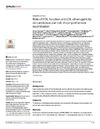Please use this identifier to cite or link to this item:
https://accedacris.ulpgc.es/handle/10553/69963
| Title: | Role of HDL function and LDL atherogenicity on cardiovascular risk: A comprehensive examination | Authors: | Hernáez, Álvaro Soria-Florido, María Trinidad Schröder, Helmut Ros, Emilio Pintó, Xavier Estruch, Ramón Salas-Salvadó, Jordi Corella, Dolores Arós, Fernando Serra-Majem, Lluis Martínez-González, Miguel Ángel Fiol, Miquel Lapetra, José Elosua, Roberto Lamuela-Raventós, Rosa María Fitó, Montserrat |
UNESCO Clasification: | 3201 Ciencias clínicas 3206 Ciencias de la nutrición |
Keywords: | High-density-lipoprotein Cholesterol efflux capacity Coronary-heart-disease Apolipoprotein-A-I Therapeutic target, et al |
Issue Date: | 2019 | Journal: | PLoS ONE | Abstract: | BackgroundHigh-density lipoprotein (HDL) functionality and low-density lipoprotein (LDL) atherogenic traits can describe the role of both particles on cardiovascular diseases more accurately than HDL- or LDL-cholesterol levels. However, it is unclear how these lipoprotein properties are particularly affected by different cardiovascular risk factors.ObjectiveTo determine which lipoprotein properties are associated with greater cardiovascular risk scores and each cardiovascular risk factor.MethodsIn two cross-sectional baseline samples of PREDIMED trial volunteers, we assessed the associations of HDL functionality (N = 296) and LDL atherogenicity traits (N = 210) with: 1) the 10-year predicted coronary risk (according to the Framingham-REGICOR score), and 2) classical cardiovascular risk factors.ResultsGreater cardiovascular risk scores were associated with low cholesterol efflux values; oxidized, triglyceride-rich, small HDL particles; and small LDLs with low resistance against oxidation (P-trend<0.05, all). After adjusting for the rest of risk factors; 1) type-2 diabetic individuals presented smaller and more oxidized LDLs (P<0.026, all); 2) dyslipidemic participants had smaller HDLs with an impaired capacity to metabolize cholesterol (P<0.035, all); 3) high body mass index values were associated to lower HDL and LDL size and a lower HDL capacity to esterify cholesterol (P<0.037, all); 4) men presented a greater HDL oxidation and lower HDL vasodilatory capacity (P<0.046, all); and 5) greater ages were related to small, oxidized, cytotoxic LDL particles (P<0.037, all).ConclusionsDysfunctional HDL and atherogenic LDL particles are present in high cardiovascular risk patients. Dyslipidemia and male sex are predominantly linked to HDL dysfunctionality, whilst diabetes and advanced age are associated with LDL atherogenicity. | URI: | https://accedacris.ulpgc.es/handle/10553/69963 | ISSN: | 1932-6203 | DOI: | 10.1371/journal.pone.0218533 | Source: | PLoS ONE [ISSN 1932-6203], v. 14 (6) |
| Appears in Collections: | Artículos |
SCOPUSTM
Citations
40
checked on Jun 8, 2025
WEB OF SCIENCETM
Citations
37
checked on Jun 8, 2025
Page view(s)
148
checked on Jul 12, 2025
Download(s)
119
checked on Jul 12, 2025
Google ScholarTM
Check
Altmetric
Share
Export metadata
Items in accedaCRIS are protected by copyright, with all rights reserved, unless otherwise indicated.
